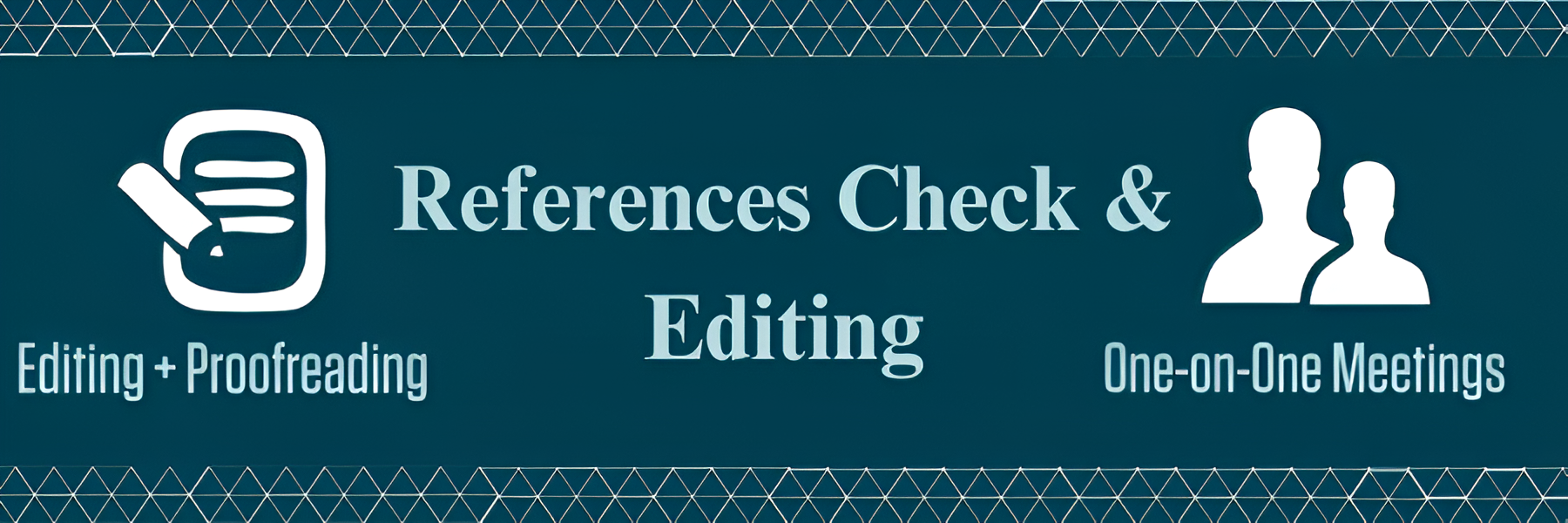


Accurate referencing is essential in academic writing to uphold credibility and avoid plagiarism. Our Expert PhD Assistance ensures every citation is properly formatted, verified, and aligned with required style guidelines. We meticulously edit reference lists, correct inconsistencies, and enhance citation clarity. This process strengthens the scholarly integrity of your work, enabling readers to trace sources accurately and boosting the overall quality of your academic submission.
1. Reference Verification: We throughly verify each reference in your document, ensuring all cited sources are accurate, complete, and correctly formatted according to your required style guide. This process guarantees that every reference meets academic standards and enhances the credibility of your work.
Ensure consistent citation formatting by following the APA referencing style. Uniform in-text citations and reference lists enhance academic integrity, improve readability, and reflect adherence to scholarly writing standards throughout your document.
Our Plagiarism free remover ensures all references and citations are correctly formatted and consistently styled. We enhance your document’s credibility by adhering to academic standards, improving clarity, and eliminating formatting issues that may affect readability and professional presentation.
Confirm the accuracy of all publication details, including authors, titles, publication dates, and sources. Cross-check these details against original documents and databases to ensure correctness. Accurate verification prevents citation errors and enhances the credibility of your references.
Throughly review your reference list to identify and remove duplicate entries. This process prevents redundancy and confusion, ensuring each source is listed only once. By eliminating duplicates, you maintain a clear, accurate reference list, enhancing the credibility and readability of your work.
Verify the accuracy of each reference by cross-checking with original sources to ensure correct author names, publication dates, titles, and page numbers. This ensures reliability and credibility in your document's reference list.
As part of a professional PhD thesis writing service, ensure uniformity in citation formatting throughout your document, adhering to the required style guide (APA, MLA, Chicago, etc.). Consistent citation style enhances professionalism and facilitates easier cross-referencing for readers.
Adhere to the specified guidelines for formatting references, including font size, spacing, and layout. Accurate formatting ensures that all references are presented uniformly, enhancing readability and meeting academic or publication standards.
Ensure each reference entry is complete and correctly formatted. Verify author names, publication dates, titles, and source details to ensure precision and reliability in the reference list, maintaining academic integrity.
Verify that all required references are included and each entry provides full details such as authors, titles, publication dates, and sources. Ensure no references are missing or incomplete for through academic documentation.
Regularly review and update your references to ensure they reflect the most current sources. Verify that all citations are accurate and include the latest versions or editions. This ensures the credibility and relevance of your work.
When publishing in Scopus-indexed journals, confirm that all publication details, such as author names, titles, publication dates, and page numbers, are correct and up-to-date. Accurate verification prevents errors and ensures that references are reliable and traceable in your work.
Make sure that all references are easily accessible to readers, including correct links and accurate retrieval information. This ensures that sources can be verified and consulted, enhancing the credibility and reliability of your work.
A: The purpose is to ensure that all cited sources are accurately listed, correctly formatted, and accessible, enhancing the credibility of your work and preventing potential issues with plagiarism or incomplete citations.
A: Check each reference against the original source for correct author names, publication dates, titles, and publication details. Use authoritative databases or the original documents to confirm accuracy.
A: Citation style consistency means adhering to a specific format (e.g., APA, MLA) throughout your document. It ensures uniformity, professionalism, and adherence to academic standards, making your work easier to follow and understand.
A: For incomplete references, locate the missing information from reliable sources or contact the original author if necessary. Ensure that all required elements are present and formatted correctly.
A: Remove duplicate entries to avoid confusion and redundancy. Verify the correctness of each reference to ensure that the unique sources are properly cited without repetition.
A: Regularly review and update your references to reflect the most recent and relevant sources. Ensure that all cited works are current and that outdated or incorrect references are removed or corrected.
A: Accuracy in the reference list is crucial for allowing readers to locate and verify the sources you used. It also helps maintain the integrity of your work and supports academic honesty.
A: Ensure that all links are functional and provide accurate retrieval information. Include details such as URLs, DOIs, or publication locations so that readers can easily access and verify your sources.
A: Proper formatting ensures that references are presented in a uniform manner according to the required citation style. This aids readability and ensures compliance with academic or publication standards.
A: Include all necessary references and verify that each one is relevant to your work. Cross-check your reference list against your citations in the text to ensure completeness and accuracy.